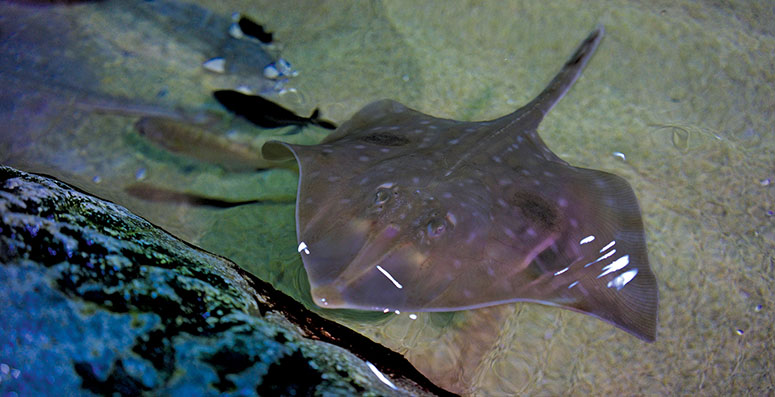There are close to 100 different species of skates worldwide, the largest of which is aptly named the big skate

Skates are flat fish with large pectoral fins that let them glide through the water. They tend to live along the sandy seafloor, where they camouflage themselves and feed on a variety of prey. Photo courtesy of Aquarium of the Bay
By Mallory Johnson
Published: June, 2016
There are close to 100 different species of skates worldwide, the largest of which is aptly named the big skate. While various species of skates can be found throughout the world, big skates are typically found in estuaries and bays along the western coasts of North America. They tend to live along the sandy seafloor, where they camouflage themselves and feed on a variety of prey that includes shrimp, worms, clams and even some fishes.
Big skates typically reach about six feet long and weigh up to 200 pounds. The largest big skate on record is nearly eight feet long. This not-quite-as-well-known cousin of the bat ray has certain similarities to its more popular relative, but also has many distinctive characteristics of its own. Like the bat ray, skates are flat fish with large pectoral fins that let them glide through the water. Another similarity to bat rays is their skeleton, which is made up of cartilage rather than bone. This is a characteristic they also share with another distant relative—sharks.
Unlike bat rays, which have raised heads and a rounded snout, the big skates’ head is flattened with a pointed tip. Their large pectoral fins, often called wings, are broadly expanded. These wings are finely pointed and attached to their head, giving the skate a shape that resembles a diamond. Skates boast slender and whip-like tails that measure almost as long as their bodies. In addition, big skates are equipped with a handy set of thorns that line the back of their bodies and tails as a clever way of thwarting predators.
The underside of big skates is a classic white, while on top they don a brown and white speckled pattern, helping them stay camouflaged along the sandy ocean floor. Their scientific name is Raja binoculata, which, once translated, is quite fitting. Binoculata means “two eyes,” referring to two large spots on their pectoral fins. These spots are believed to be another clever defense mechanism, meant to deceive predators into thinking they are actually eyes, tricking them into believing that the skate is much larger than it really is.
As a flat fish, both eyes are on the dorsal, or upper, side of its body. Skates will frequently hide motionless on the bottom of the ocean with only their eyes protruding from the tops of their heads. Meanwhile, their mouths can be found on the underside of their bodies along with five gill slits. Skates intake water through openings called spiracles on the top of their heads, then push it out through their gills, enabling them to breathe while buried in the sand. This respiration method also conveniently helps them stay buried in their preferred location.
Learn more about big skates at Aquarium of the Bay, where you can see and even touch these majestic animals. Find out more at www.aquariumofthebay.org.
Mallory Johnson is the Communications Manager at Aquarium of the Bay, a nonprofit dedicated to protecting, restoring and inspiring the conservation of San Francisco Bay and its watershed.

